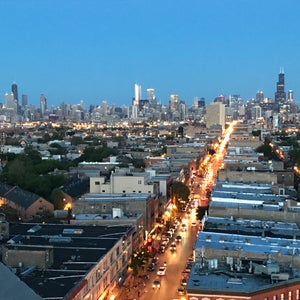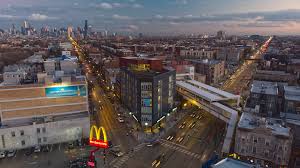
Located in the east of Chicago’s Logan Square area, Bucktown lies north of Wicker Park and northwest of the Loop. It earned its name from the abundant goats kept in the area in the 19th century, when it was part of the city’s Polish Downtown. The Polish term for Bucktown is Kozie Prery, which means Goat Prairie. Its borders are Fullerton Avenue in the north, Western Avenue to the west, Bloomingdale/North Avenue to the south, and the Kennedy Expressway to the east. Historically, its borders were Fullerton Avenue, Damen Avenue (formerly Robey Street), Armitage Avenue and Western Avenue.
Bucktown is a primarily residential area, with a variety of housing ranging from older single family homes, to modern builds with unique architecture, to industrial lofts. Established in 1920, Horween Leather Company is located on North Elston Avenue. The neighborhood has its roots in the 1830s, when Polish immigrants began to settle in the area. This immigration increased in 1848 when many Germans arrived, resulting in the town of Holstein’s creation in 1854. This was later annexed into Chicago in 1863. During the 1890s and 1900s, immigration from Poland, the incorporation of Jefferson Township into Chicago and the completion of the Logan Square Branch of the Metropolitan Elevated Lines caused a sharp population increase. Three churches designed in the “Polish Cathedral style” – St. Hedwig’s, the former Cathedral of All Saints, and St. Mary of the Angels – were constructed during this time.
When Polish settlers first inhabited Bucktown, they gave its streets names meaningful to their culture: Kosciusko, Sobieski, Pulaski, and Leipzig (after the Battle of Leipzig). However, in 1895 and 1913, Chicago’s City Council, heavily influenced by a German political force based in Bucktown, altered the Polish titles to Hamburg, Frankfort, Berlin, and Holstein. During WWI, due to anti-German sentiment, the names were changed once again, leaving us with the very Anglo-Saxon-sounding McLean, Shakespeare, Charleston, and Palmer.

During and after World War II, a large wave of Polish immigration caused the population of Polish Downtown to climb to an estimated 150,000 between 1939 and 1959. Like the Ukrainians in Ukrainian Village, they chose to live in these ethnic enclaves for the convenience of shops, restaurants, and banks that catered to their language. Milwaukee Avenue was the heart of the city’s “Polish Corridor”, a stretch of Polish settlement from Polonia Triangle to Avondale’s Polish Village. European Jews and Belarusians were other groups that were drawn to the area during this period.
The immigration of Latin American people to the locality began in the 1960s, with a substantial number of Cubans and Puerto Ricans relocating to the region. The Puerto Ricans were displaced from Lincoln Park in the 1960s and settled in the areas near Damen and Milwaukee Avenues until the 1980s. This demographic lent their support to Harold Washington’s campaign in his successful run for mayor, with the Young Lords as a prominent part of the effort. At the end of the twentieth century, the growing artistic community triggered gentrification, which saw a marked influx of young professionals. In more recent years, numerous restaurants and pubs have opened in the area, and some older housing has been demolished and then replaced by larger and more upmarket dwellings.
Damen Avenue in Bucktown is home to a bustling commercial district ranging from North Avenue in Wicker Park to Webster Avenue. The Blue Line provides easy access to the area, and there are multiple entrances to the 606, formerly known as the Bloomingdale Trail.
Bucktown is situated 5.2 miles away from the Downtown Chicago area, and can be reached by car, bike, or public transportation. It borders the Chicago River and is close to Naperville, IL. The zip codes in the area are 60622, 60647, and 60614. This vibrant neighborhood is known for its trendy atmosphere and its closeness to the heart of Chicago.
When it comes to getting around the city, travelers have two choices. The Rail Station (METRA) is one option, and the other is the CTA Buses via the Chicago Transit Authority. Furthermore, the Damen station of the CTA Blue Line can be used to access Buckton as part of Chicago’s “L” system.
No matter the route you take, there is a bus that runs every six, twelve, and twenty minutes. If you are planning on driving or taking public transit, it is recommended that you plan for extra time to get to work, as the proximity to the city center brings more traffic.
Residents of the area have a variety of entertaining occasions to look forward to in the course of the year, such as the Bucktown Arts Fest, Bucktown Garden Walk, and Chillfest Chicago.

A couple of places to visit at any time of the year include St. Mary of the Angels Catholic Church and the National Museum of Puerto Rican Arts & Culture. They are both great attractions to add to a list of fun events that happen throughout the year.
The nighttime scene is vibrant. If you’re interested in visiting bars, cafes, theaters, or pubs, there are plenty of options. You will come across a combination of metropolitan and suburban lifestyles, so if you prefer not to stay out late, you’ll have lots of activities to choose from regardless of your age.
The community has kept its historic character while also modernizing the area with the introduction of new features such as trendy fitness centers, bars, and cafes.
It is a common misconception that Bucktown and Wicker Park are the same neighborhood. While the two areas do share quite a few similarities, they are divided by the 2.7 mile-long 606 walkway, a repurposed railway line.
Though the area is not extensively large, it is an ideal spot for those who want to live near the city, but not be surrounded by its constant hustle and bustle on a daily basis.

